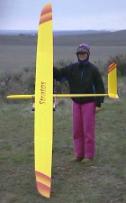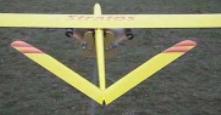|
History
of Thermal Techniks (quoted from her Homepage)
In
1991, Steve Harvey was flying thermal soaring competitions with the FACCT
club, consisting of Chris Tompkins, John Shaw and Neil Webb. At BARCS
Interglide, Steve met Vojtech Valenta and his family, from the Czech Republic.
At this time Steve was considering producing his own moulded competition
gliders, but on seeing the DOGAN and THERMIK B models being flown by Vojtech,
he decided that it would be better to import these models than manufacture
his own. After a brief discussion in German, with Vojtech, a deal was
struck between Steve, Neil Webb and
VJV (Vojtech and Josef Valenta) to distribute their models and so
THERMAL TECHNIKS was born. At this time the only other fully moulded glider
available was the Ellipse F3B, but it was expensive and there was a long
waiting list. The DOGAN was immediately popular and became a best selling
model, not only because it was half the price of the Ellipse, but it flew
very well and was very tough. It had the Quabeck HQ2,5/9 section which
was not trendy at the time for F3B, so the DOGAN did not get to be seen
in too many F3B competitions. As a slope sport model and a windy weather
F3J model though, it was superb and over 200 happy THERMAL TECHNIKS customers
who bought them In Britain and around the world, cannot be wrong. The
Thermik B was the first all moulded F3J glider. It also flew well and
was very under-rated except by those who flew them. It completely surprised
quite a few 'top' pilots who tried to out -scratch one. Over the next
few years, other models were introduced, the PARABOLA F5B 10 cell electric
model and the TRIFFIK speed 400 racer. Both were the first all moulded
models in their class and became the standard for others to follow. Steve
named the TRIFFIK because it is just terrific to fly (corny but true).
In 1993, Steve had specified to VJV, a model for use in F3J, which was
to be the standard for that class for a long time. The model had to combine
the handling of the DOGAN and the soaring of ability of the THERMIK B,
3,4 to 3,5 m wingspan and using the new SD7037 section. The THERMIK C
was designed and produced to this specification.By now, THERMAL TECHNIKS
was supplying models to customers all around the world. The THERMIK C
had a long gestation period and did not see production until July 1995.
By this time it was too late for Neil to fly one, as he tragically died,
soon after winning the French F3J international event with his THERMIK
B. Neil's death was a huge loss to the world of Thermal Soaring as he
was one of the originators of BARCS and the percentage slot thermal soaring
competition and had represented Britain in the F3B World Championships.
Neil also made a great contribution to the beginnings of thermal soaring
as an international class, with the introduction of F3J and also running
the first F3J league events in Britain. He has been honoured by having
the magnificent F3J World Championship Trophy named after him. Steve continued
THERMAL TECHNIKS and the range was increased with the DOGAN replacement,
the DRAGON, in 1996, along with the now famous THERMIK V which is one
of the best all round thermal soarers to date. In 1997 the glider version
of the PARABOLA was introduced and became an immediate hit with the local
slope soarers. Although VJV models always performed excellently, have
won a great many competitions and represent great value for money, there
were now other suppliers and pretend suppliers with moulded gliders on
the market. THERMAL TECHNIKS therefore had to expanded the range of models
and did so with range of several new sport models. In 1999 some events
happened that changed the course of THERMAL TECHNIKS. Firstly, After a
discussion with Steve at the F3J World Championships in 1998, Rob Ashley
came back to F3J after a long lay off and along with Mark Vandervelden,
Tony Gibbons and Andre Borowski, the F3J Team Banana was formed, named
so after their bright yellow jackets. The second thing was Rob agreed
to be part sponsored and fly for THERMAL TECHNIKS exclusively, in exchange
for producing the web site. Roger Knights won the British F3J league convincingly,
flying a THERMIK V, thereby proving all the critics of the THERMIK very
wrong. In 1999 Steve was also introduced to Jsenek Jesina who produces
the STRATOS range of gliders and is now the exclusive distributor for
those models in the U.K. THERMAL TECHNIKS now supply a number of the less
expensive sport models to the trade. The final seminal event for THERMAL
TECHNIKS In 1999 was Steve tried his hand at aerotowing for the first
time with his second hand 1/4 scale Discus and could see a future in this
most enjoyable pastime. Let us see how THERMAL TECHNIKS will develop in
the new millennium.
|








